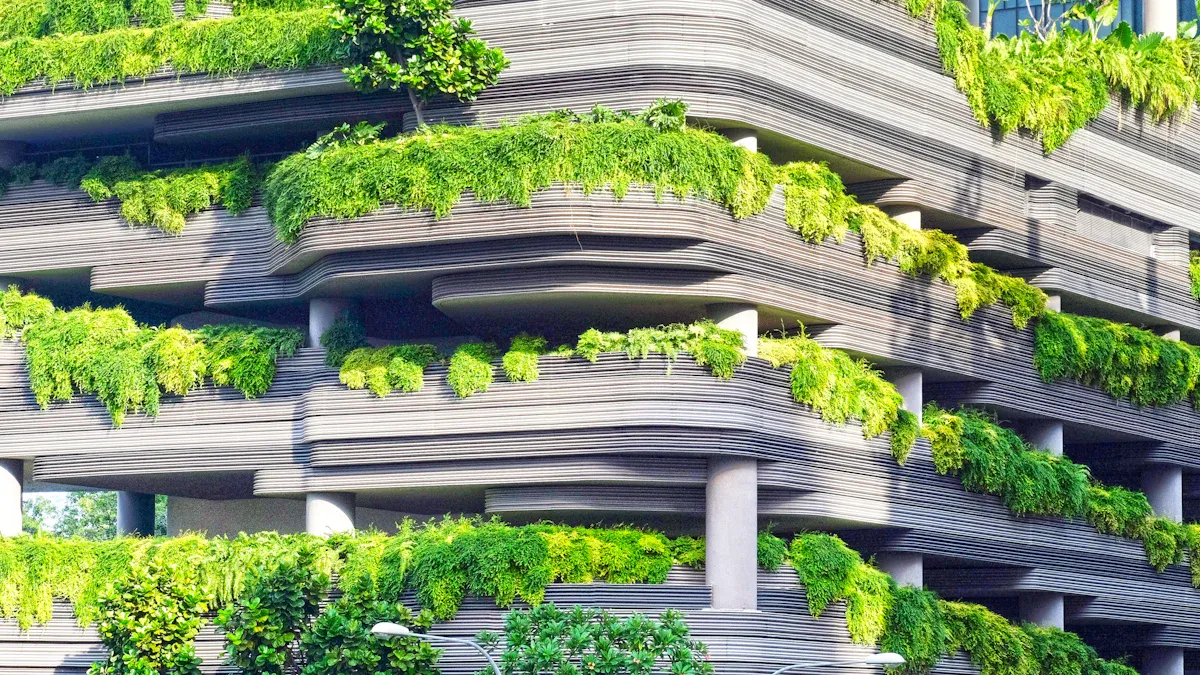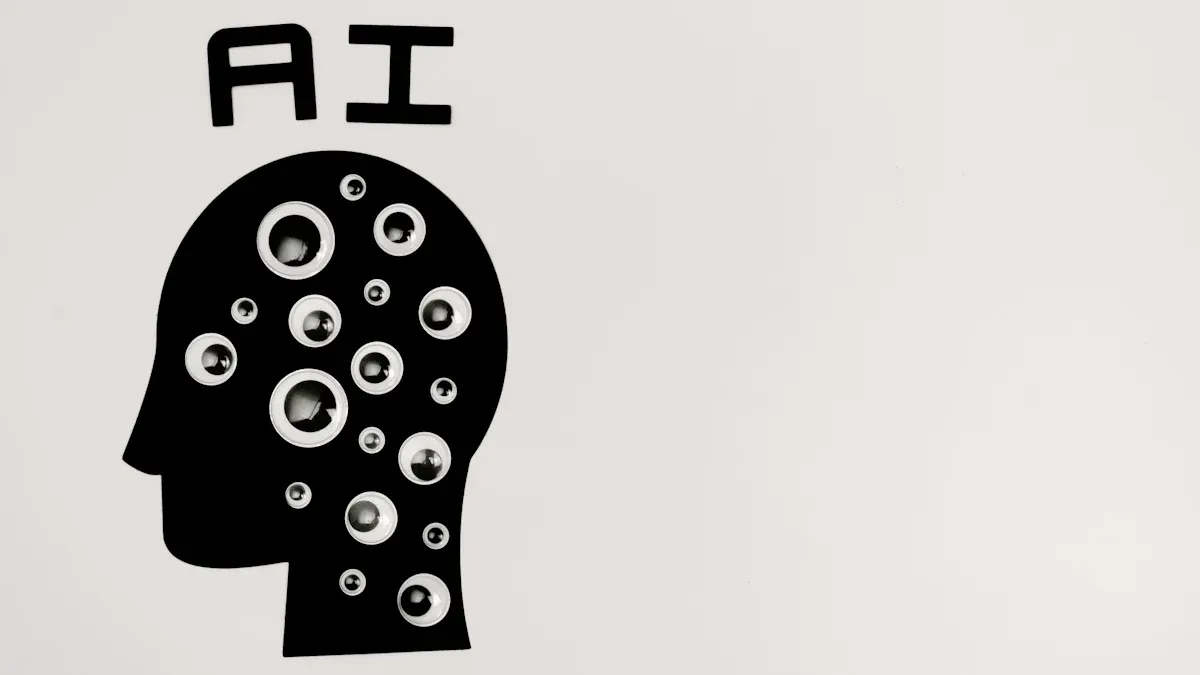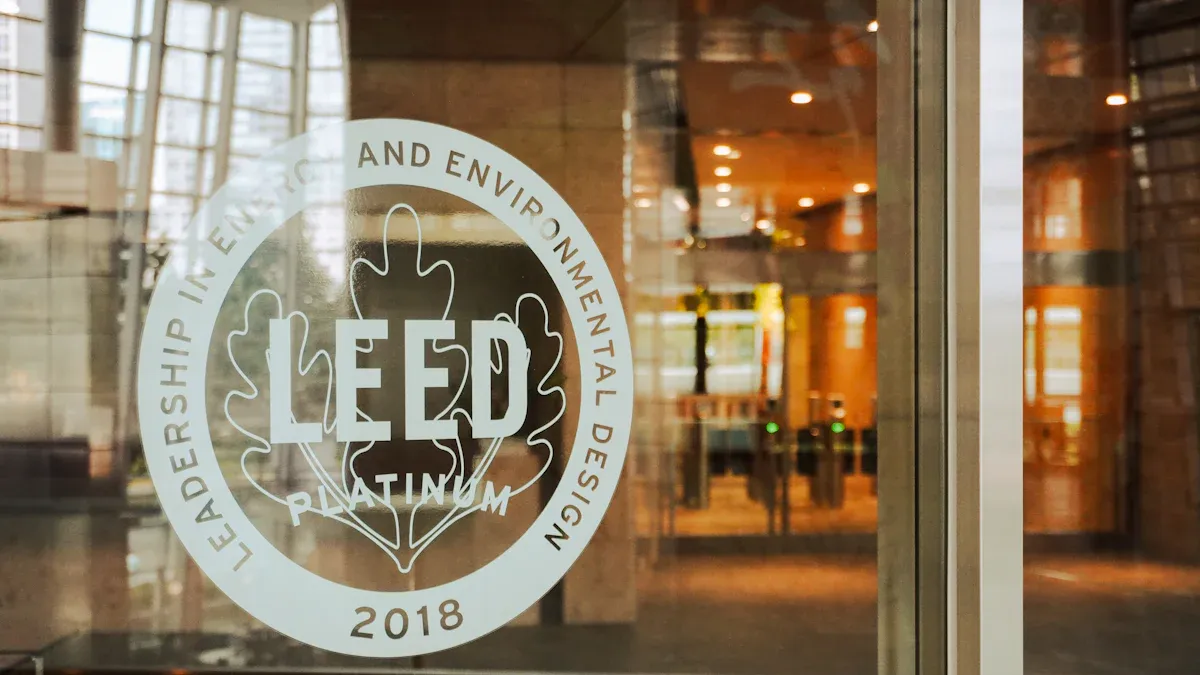How Deploying AI in Store Tech Can Streamline Your LEED Process in 2025

Deploy ai in store technology to make getting LEED certification faster. More digital tools are now used in stores with real products. This means we need smart solutions more than ever. AI helps you waste less and use energy in a smarter way. This supports your sustainability goals. It also gives customers what they want from green brands.
Practical Benefit | How It Helps You |
|---|---|
Automated compliance checks | AI makes reports and saves you time. |
Real-time monitoring | You track progress as it happens. |
AI cuts costs by making tasks easier. |
When you use AI, you get a clear benefit. You can turn your sustainability plans into real results.
Key Takeaways
Using AI in your store can make the LEED process faster. This helps you save both time and money.
AI tools give you real-time data about energy and water use. You can make quick changes to use less and be more efficient.
Digital twins let you try out changes on a computer first. This helps you follow LEED rules before you make real changes.
AI can check if you are following the rules automatically. This means you do not have to do as much work by hand. It also helps you make fewer mistakes in your LEED paperwork.
Start with small AI tools, set easy-to-understand goals, and watch your progress. This will help you get better at being sustainable.
Why Deploy AI in Stores

AI Trends in Retail
Every year, new technology changes how stores work. When you use ai in your store, you join a big change in shopping and helping the planet. Many stores now use AI to do jobs faster and check their green goals better. Here are some new things happening:
AI tools show you energy use and waste right away.
AI lets you see your supply chain and carbon footprint more clearly.
Tougher energy and carbon laws make stores use smarter tech.
Big stores like Target and Walmart want LEED certification and use green energy.
Tip: Watching these trends helps you keep up with rules and what customers want.
Impact on LEED Goals
AI helps you reach LEED goals by making your store work smarter. You can use smart sensors and IoT devices to watch energy, people, and temperature. AI changes lights and HVAC as needed, so you save energy without trying. Tools that predict problems help your machines work longer and waste less. Using ai also gives you more control over your supply chain and waste.
AI follows products from start to end, making your supply chain clearer.
It cuts waste by guessing what you need and using less.
AI checks if your suppliers follow green rules.
It helps stop too much stock and extra packaging.
AI picks the best delivery routes to use less fuel.
Stores can save a lot of money with AI building tools. Some stores save half on energy bills. These savings help your business and make it better for renters and buyers.
Benefit | Description |
|---|---|
Energy Efficiency | AI helps you use less energy and spend less money. |
Higher Property Value | LEED stores often sell or rent for more money. |
Lower Operating Costs | Smart upgrades mean you pay less to run your store. |
Increased Rental Income | LEED stores can get up to 20% more rent. |
Showing your energy savings also makes your company look good. This gives you a great story to tell customers and investors.
AI and LEED Process

Automated Compliance
Using ai in your store makes the LEED process much easier. AI tools help you gather and sort all the documents you need. These tools check your files with LEED rules and tell you your progress. You do not need to spend hours searching for missing papers or checking rules by yourself. AI dashboards show how many points you have and give tips to get a better score.
Here is how AI can help with the main LEED steps:
Step in LEED Certification Process | Automation Method Using AI |
|---|---|
Documentation Gathering | AI agents collect data from many places automatically. |
Compliance Verification | AI checks your documents with LEED standards all the time. |
Progress Tracking | Dashboards show real-time updates on your points. |
Recommendations for Optimization | AI suggests new materials and design changes using data. |
When you use ai, you save time and make fewer mistakes. Automated tools also help you get recertified more easily later.
Note: AI makes less manual work and more accuracy. You can find problems early and fix them before they slow you down.
Real-Time Data
You need real-time data to reach LEED goals. AI helps you collect and use this data every day. Smart sensors track how much energy and water your store uses. They also watch air quality and waste. AI looks at this data and makes changes right away to save resources.
Here are some real-time data types that matter for LEED and how AI helps:
Type of Real-Time Data | AI Facilitation |
|---|---|
Energy Efficiency | AI changes systems to use less energy and keep comfort. |
Water Efficiency | AI finds leaks, manages watering, and helps recycle water. |
Indoor Environmental Quality | AI checks and changes air quality like CO2 and humidity. |
Materials and Resources | AI tracks green materials and waste management. |
Sustainable Sites | AI manages landscaping, stormwater, and heat island plans. |
AI gives you feedback right away. You can see if your store uses too much energy or water. You can also check if the air is clean and safe. This helps you stay on track for LEED and fix problems before they grow.
Digital Twins
Digital twins use AI to make a virtual copy of your store. This copy shows how your building works in real time. You can test changes in the digital twin before trying them in your real store. AI digital twins check if your store follows LEED rules. They use computer vision and data to watch your store and make sure you meet safety and efficiency standards.
Digital twins help you spot problems before they happen.
You can try new ideas without risk.
You can use them to show proof for LEED.
Some tools use digital twins to check your credits and model energy use.
When you use ai with digital twins, you make the LEED process faster and more reliable. You can show your progress to auditors and get certified with less stress.
Tip: Digital twins help you plan upgrades and see how they will change your LEED score before you spend money.
Case Studies
Retail Success Stories
You can see how real companies use technology to meet LEED goals. Many stores and factories have changed a lot by using smart tools and AI. These companies show what you can do if you use AI in your store or building.
Retailer | LEED Certification Achievements |
|---|---|
QUALCOMM | Wants zero net emissions by 2040 and uses LEED for new buildings. |
Microsoft | Tries for LEED Gold for its data centers to be more green. |
NVIDIA | Got LEED Gold for its main office and wants Gold for new ones. |
TSMC | Has over 40 LEED projects with more than 5 million square meters. |
Samsung | Many buildings, like factories and offices, have LEED certification. |
Intel | All new buildings must get LEED since 2011 as a company rule. |
These companies use AI to watch energy, manage resources, and make better building designs. You can learn from them and see how smart tech helps you reach high goals.
Tip: See what these leaders do. You can copy their steps and use AI to make your store greener and work better.
Lessons Learned
You can learn good lessons from companies that use AI for LEED. They show how smart tools help with planning, save time, and help you make better choices.
Company | AI Application Description | Key Results |
|---|---|---|
Levi Strauss | Used analytics to study demand signals for supply chain management. | Made better choices and smarter demand plans |
Sport Clips | Made AI tools to help with hiring and staffing. | Hired faster and had more staff |
SPAR ICS | Used AI for delivery and inventory management. | Predicted inventory better and wasted less |
Ulta Beauty | Used AI for customer experience and marketing. | Got customers more interested |
You can use AI to make faster choices and have fewer mistakes.
Smart tools help you guess what you need and waste less.
AI helps you manage workers and resources better.
You can make customers happier and save money.
Note: When you use AI, you get more control and better results. You can reach your LEED goals and make your business stronger.
How to Deploy AI for LEED
Steps to Start
You can begin your LEED journey with AI by following a few simple steps. First, look at your store’s current systems. Find out where you use the most energy or create the most waste. Next, choose the right AI tools for your needs. Many companies offer smart sensors, dashboards, and digital twins. Work with your team to set clear goals for energy savings and LEED points. Start small with one store or one system. Test the results before you expand.
Quick Start Checklist:
Review your store’s energy and waste data.
Pick AI tools that match your LEED goals.
Train your staff on new technology.
Set up a pilot project.
Track results and adjust as needed.
Tip: You do not need to change everything at once. Small steps help you learn and grow.
Overcoming Challenges
You may face some challenges when you deploy ai in your store. Some staff may not know how to use new tools. You might worry about costs or data security. To solve these problems, offer training and clear guides. Choose AI tools with strong support and easy updates. Work with experts who know both AI and LEED rules. Keep your team involved so everyone feels ready for change.
Challenge | Solution |
|---|---|
Staff training | Provide simple guides and demos |
Cost concerns | Start with a small pilot |
Data security | Use trusted AI providers |
Note: Education and teamwork make your AI project stronger.
Measuring Results
You need to measure your progress to see if your AI tools help with LEED. Use dashboards to track energy, water, and waste. Compare your numbers before and after you deploy ai. Share your results with your team and your customers. Good data helps you get LEED points and shows your success.
Ways to Measure Impact:
Track energy and water use each month.
Count waste and recycling rates.
Check indoor air quality.
Review LEED scorecard updates.
Celebrate your wins and use your data to plan next steps.
When you deploy ai in your store, you make LEED certification easier and help your business stay strong for the future. AI helps you cut waste, manage inventory, and lower carbon emissions. Early adopters like Starbucks show that starting now brings lower costs and better customer satisfaction.
AI makes your supply chain smarter and your store more efficient.
You can keep learning and updating your tools for the best results.
Ready to take the next step?
Set clear goals
Choose the right AI tools
Start small and grow your success
FAQ
What is LEED certification?
LEED stands for Leadership in Energy and Environmental Design. You earn this certification when your store meets green building standards. LEED helps you save energy, use resources wisely, and show your commitment to the environment.
How does AI help with LEED compliance?
AI tracks your store’s energy, water, and waste. You get real-time updates and alerts. AI also checks your documents and helps you meet LEED rules faster.
Is AI hard to set up in my store?
You can start with simple AI tools like smart sensors or dashboards. Many companies offer easy setup and training. You do not need to be a tech expert.
Tip: Start small and add more tools as you learn.
What are the main benefits of using AI for LEED?
Save money on energy and water bills
Get LEED points faster
Make your store greener
Show customers you care about the planet
See Also
The Future of Retail Lies in AI-Driven Stores
Transforming Online Retail Management with AI-Driven Tools
Understanding the Growth of AI-Enhanced Corner Stores
Launching a Low-Cost AI-Driven Corner Store Successfully
Modern Retail Benefits from Features of AI-Enhanced Vending Machines
